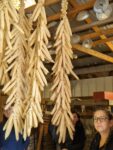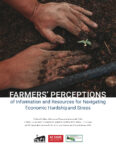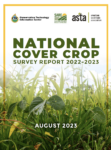Showing 51-60 of 104 results
New Podcast Episode: "Breeding Squash for Disease Resistance and Eating Quality"
This episode of ATTRA's Voices from the Field podcast highlights the importance of local seed development and encourages passionate farmers to begin their own seed growing journey.

A Path to Farm Community
Farmers, like all of us, need time and strength to focus on relationships, health, healing and a sense of belonging, yet many agriculture service providers are unable to give wellness the attention it needs. A recent Cornell Small Farms project, Reconnecting with Purpose, aimed to provide farmers with additional support to cope with the hard […]

Water and Wonderment Abounds on WI State Tour for SARE Fellows
They gathered from their respective home waters—the Yahara, Shenendoah, Black Root, Vermillion, Marias, from Kansas, and all the way to the Delta and Everglades Basin—in fellowship to learn from the foodsheds of the dairy state and each other. State-based study tours are the current that charts the course for participants of the SARE Fellows program. […]
New Podcast Episode: "The Commercial Potential of Mulberries in the Midwest"
In this episode of ATTRA's Voices from the Field podcast, Weston Lombard and NCAT Sustainable Horticulture Specialist Guy Ames discuss the commercial possibilities and challenges mulberries present, along with different cultivars and growing strategies.

Changing Lives Through Better Communication
After a particularly stressful first year of farming on his own, organic vegetable farmer Marc Cavatorta was seeking support from other farmers. He found it when he attended a reflective retreat held not far from his farm in Palermo, Maine. “The retreat offered a chance to be with other farmers who were willing to talk […]
New SARE Video: Ecological Weed Management at the Martens Farm
Farmers nationwide are tackling the challenge of using ecological principles to manage weeds using fewer herbicides. Understanding the biology of weeds is key to helping producers adopt innovative strategies that achieve strong yields while adapting to changing consumer preferences. Three new videos from SARE illustrate how Klaas and Mary-Howell Martens manage weeds without chemicals on […]

SARE Welcomes New Fellows
The Sustainable Agriculture Research and Education (SARE) program announces the addition of four new members to the SARE Fellows program. Each member represents a different region of the United States. SARE Fellows is a two year professional development experience that helps agricultural educators enhance their understanding of sustainable agriculture and build relationships with farmers and […]

Planting Seeds of Help
Despite years of experience, fifth-generation flower farmer Leroy Hardy was facing foreclosure on his farm near Sedley, Virginia. To navigate the financial crisis, Hardy reached out to Rural Advancement Foundation International (RAFI) for mediation assistance, and he emerged with his assets intact. So when RAFI, the Land Loss Prevention Project (LLPP) and the National Center […]

New Cover Crop Survey Data Challenges Assumptions on Role of Incentive Payments
Adapted from the Conservation Technology Information Center: A new national survey report has found that the vast majority of farmers who use cover crops don't need incentive payments to continue with the practice because of how much they appreciate its value to their land and business. According to the National Cover Crop Survey, incentives play a key […]

Virginia Hosts National SARE Fellows Tour and Training
The sustainability of farms and food-related businesses can be affected by many agricultural, social, ecological, financial, and cultural factors and issues that can vary from state to state and from region to region. These issues range from market access and development needs to production challenges, lack of food system infrastructure such as aggregation and processing, […]